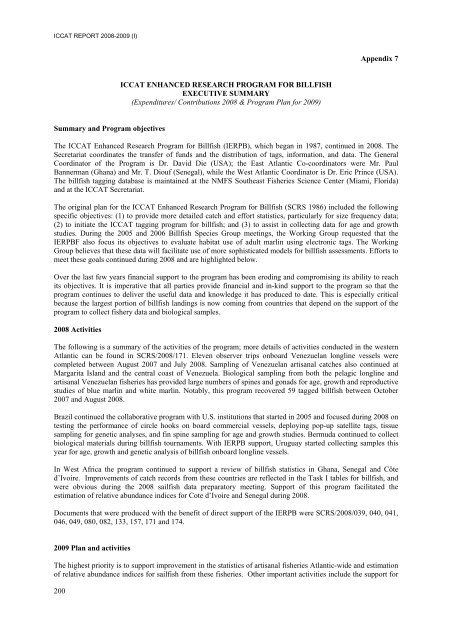REPORT OF THE STANDING COMMITTEE ON RESEARCH ... - Iccat
REPORT OF THE STANDING COMMITTEE ON RESEARCH ... - Iccat
REPORT OF THE STANDING COMMITTEE ON RESEARCH ... - Iccat
You also want an ePaper? Increase the reach of your titles
YUMPU automatically turns print PDFs into web optimized ePapers that Google loves.
ICCAT <strong>REPORT</strong> 2008-2009 (I)Appendix 7ICCAT ENHANCED <strong>RESEARCH</strong> PROGRAM FOR BILLFISHEXECUTIVE SUMMARY(Expenditures/ Contributions 2008 & Program Plan for 2009)Summary and Program objectivesThe ICCAT Enhanced Research Program for Billfish (IERPB), which began in 1987, continued in 2008. TheSecretariat coordinates the transfer of funds and the distribution of tags, information, and data. The GeneralCoordinator of the Program is Dr. David Die (USA); the East Atlantic Co-coordinators were Mr. PaulBannerman (Ghana) and Mr. T. Diouf (Senegal), while the West Atlantic Coordinator is Dr. Eric Prince (USA).The billfish tagging database is maintained at the NMFS Southeast Fisheries Science Center (Miami, Florida)and at the ICCAT Secretariat.The original plan for the ICCAT Enhanced Research Program for Billfish (SCRS 1986) included the followingspecific objectives: (1) to provide more detailed catch and effort statistics, particularly for size frequency data;(2) to initiate the ICCAT tagging program for billfish; and (3) to assist in collecting data for age and growthstudies. During the 2005 and 2006 Billfish Species Group meetings, the Working Group requested that theIERPBF also focus its objectives to evaluate habitat use of adult marlin using electronic tags. The WorkingGroup believes that these data will facilitate use of more sophisticated models for billfish assessments. Efforts tomeet these goals continued during 2008 and are highlighted below.Over the last few years financial support to the program has been eroding and compromising its ability to reachits objectives. It is imperative that all parties provide financial and in-kind support to the program so that theprogram continues to deliver the useful data and knowledge it has produced to date. This is especially criticalbecause the largest portion of billfish landings is now coming from countries that depend on the support of theprogram to collect fishery data and biological samples.2008 ActivitiesThe following is a summary of the activities of the program; more details of activities conducted in the westernAtlantic can be found in SCRS/2008/171. Eleven observer trips onboard Venezuelan longline vessels werecompleted between August 2007 and July 2008. Sampling of Venezuelan artisanal catches also continued atMargarita Island and the central coast of Venezuela. Biological sampling from both the pelagic longline andartisanal Venezuelan fisheries has provided large numbers of spines and gonads for age, growth and reproductivestudies of blue marlin and white marlin. Notably, this program recovered 59 tagged billfish between October2007 and August 2008.Brazil continued the collaborative program with U.S. institutions that started in 2005 and focused during 2008 ontesting the performance of circle hooks on board commercial vessels, deploying pop-up satellite tags, tissuesampling for genetic analyses, and fin spine sampling for age and growth studies. Bermuda continued to collectbiological materials during billfish tournaments. With IERPB support, Uruguay started collecting samples thisyear for age, growth and genetic analysis of billfish onboard longline vessels.In West Africa the program continued to support a review of billfish statistics in Ghana, Senegal and Côted’Ivoire. Improvements of catch records from these countries are reflected in the Task I tables for billfish, andwere obvious during the 2008 sailfish data preparatory meeting. Support of this program facilitated theestimation of relative abundance indices for Cote d’Ivoire and Senegal during 2008.Documents that were produced with the benefit of direct support of the IERPB were SCRS/2008/039, 040, 041,046, 049, 080, 082, 133, 157, 171 and 174.2009 Plan and activitiesThe highest priority is to support improvement in the statistics of artisanal fisheries Atlantic-wide and estimationof relative abundance indices for sailfish from these fisheries. Other important activities include the support for200
















